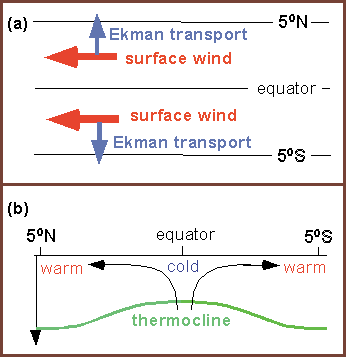Equatorial upwelling
|
B. Geerts and E. Linacre |
7/'98 |
![]()
|
It may be an exaggeration to say that the Coriolis force is negligibly small near the equator. The upwelling of colder ocean water at the equator is an example of a situation where the Coriolis force, although small, is important. Imagine a steady easterly wind along the equator (Fig 1). Since the Ekman transport (Section 11.4) is to the left of the wind in the south, and to the right in the north, this wind induces a perpendicular flow of water away from the equator, in both hemispheres. The divergent flows of near-surface water create a ‘parting’ along the equator, like one combed on the head. The consequent upwelling from depths where temperatures are low produces a line of cooler sea surface at the equator. The lower SST induces two thermally direct atmospheric circulation cells, one in each hemisphere, with subsidence and suppressed convection at the equator, and uplift and enhanced convection (the ITCZ) a few degrees poleward. These small cells are opposite to the much larger Hadley cells. This idealized picture is rarely present because the surface easterly winds may not be strong enough, or because of the presence of continents. It is best established in the central and eastern equatorial Pacific, especially during La Niña years. At this time, a strong easterly Trade wind blows, and low SSTs prevail along the equator. The ITCZ is best established at 5° N. The southern ITCZ is weaker and only present west of the dateline, because of the widespread low SST off South America, due to the Humboldt current. |
Fig 1. Ekman pumping along the equator. (a) shows a plan view of the prevailing surface wind and resulting water transport in the ocean's Ekman layer. (b) is a corresponding cross section, showing the upwelling and resulting SST anomalies. |
Ekman pumping is also important along coasts (Section 11.4), e.g. along the west coast of South Africa and Namibia. Apart from the equator, Ekman pumping also occurs in open ocean areas where the surface wind has cyclonic shear. Such shear exists, for instance, just poleward of the belt of strongest westerly winds.
